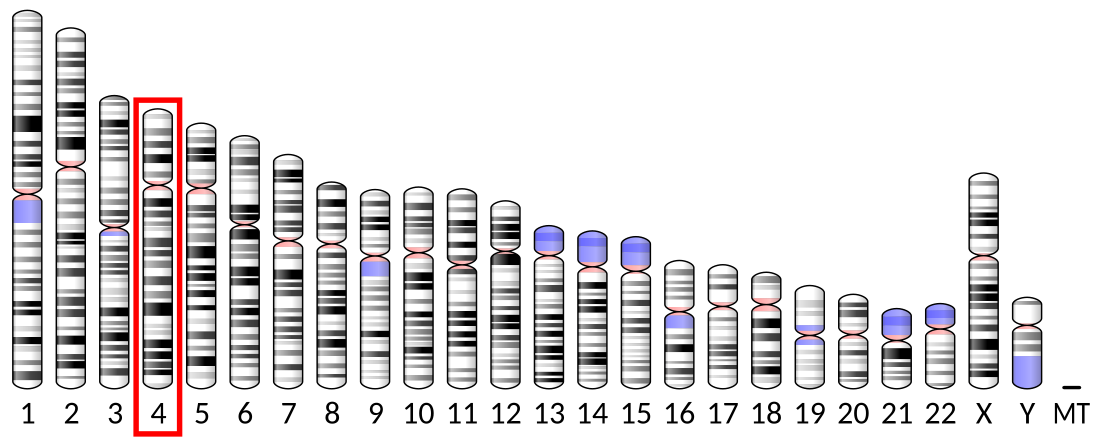Top Qs
Timeline
Chat
Perspective
CFAP299
Protein found in humans From Wikipedia, the free encyclopedia
Remove ads
Cilia- and flagella-associated protein 299 (CFAP299) is a protein that in humans is encoded by the CFAP299 gene. CFAP299 is predicted to play a role in spermatogenesis and cell apoptosis.[5]
Remove ads
Gene
Location
CFAP299 gene is located at chromosome 4, 4q21.21 spanning 642,492 bases from position 80,321,265 to position 80,963,756 on the plus strand. CFAP299 gene is also known as C4orf22, chromosome 4 Open Reading Frame 22 and Uncharacterized Protein C4orf22.[6] CFAP299 gene is located near MRPS25P1 and BMP3 and it has 13 exons.[7]

Expression
CFAP299 is widely expressed in a variety of normal tissue in Homo sapiens . CFAP299 is highly expressed in testis, trachea, lung, fetal lung and epididymis.[8] In terms of health state, CFAP299 has a decreased expression level in glioma, germ cell tumors and chondrosarcoma. An even higher expression of CFAP299 is shown in condition of soft tissue tumor and muscle tissue tumor. CFAP299 is only exist in fetus and adult.[9]

Promoter
The promoter of CFAP299 gene is predicted to present 1000 base pairs upstream of the start of transcription. A variety of transcription factors such as CCAAT binding factors, X-box binding factors and AT rich interactive domain factor bind to promoter to regulate the sequence.[10]
Remove ads
mRNA
Splice variants
CFAP299 has 9 alternatively spliced variants and 1 unspliced form.[11]
Protein
Summarize
Perspective
General feature
CFAP299 protein contains 233 amino acids in length. The molecular weight of Homo sapiens CFAP299 protein is 26869 Da and the predicted isoelectric point is 5.28. Total number of negatively charged residues is 39 and total number of positively charged residues is 33.[12] Aspartic acid has a higher frequency in CFAP299 protein than in other human proteins.[13]
Isoforms
CFAP299 protein has two important isoforms. Cilia- and flagella-associated protein 299 isoform 1 is the longest isoform[7] and cilia- and flagella-associated protein 299 isoform 2 is chosen as canonical sequence,[14] which is also the target for this article.
Domains
There is only one conserved domain DUF4464 from position 13 to position 232 in CFAP299 protein.[7] This domain belongs to DUF4464 family, which is found in eukaryotes and the proteins in this family has a length of 224 to 241 amino acids.[15] This domain is conserved through the orthologs of CFAP299 as indicated by BLAST.[16]
Secondary structure
CFAP299 proteins secondary structure is dominated by alpha helix and random coil as predicted by GOR4.[17]

Tertiary structure
Tertiary structure of CFAP299 protein predicted by I-TASSER showed that the protein is comprised by alpha helix and coils.[18]

Post-translational modifications
CFAP299 is predicted to undergo phosphorylation in various site as shown in graph.[19] CFAP299 also predicted to have sumoylation site in position 58, 137 and 232 and two SUMO-interaction Motifs in position 45-49 and 212-216.[20]


Subcellular localization
Interacting proteins
CFAP299 protein is believed to interact with amyloid beta (A4) precursor protein (APP)[22] and BCL2-associated athanogene 3 (BCL2).[23]
Evolution
Summarize
Perspective
OrthologS
CFAP299 protein orthologs exists in mammals, reptiles, birds, amphibians, fish, sponges, sea urchins, insects, fungi and plants. Its most distant relative appear in plants. The table below shows orthologs found by BLAST.[16]
| Genus and species | Common name | Taxonomic Group | Date of divergence | accession number | sequence length | sequence identity | sequence similarity |
| Homo Sapiens | Human | Mammalia | 0 | NP_689983.2 | 233 | 100% | 100% |
| Ochotona princeps | American pika | Lagomorpha | 88 | XP_004590671.1 | 233 | 85% | 93% |
| Mus musculus | House mouse | Rodentia | 88 | NP_001019785 | 233 | 85% | 91% |
| Eumetopias jubatus | Steller sea lion | Carnivora | 94 | XP_027980031 | 233 | 86% | 93% |
| Erinaceus europaeus | European hedgehog | Soricomorpha | 94 | XP_007518562 | 233 | 83% | 93% |
| Ornithorhynchus anatinus | platypus | Monotremata | 169 | XP_007659769 | 164 | 74% | 88% |
| Pogona vitticeps | Central bearded dragon | Reptilia | 320 | XP_020658829 | 236 | 72% | 85% |
| Anolis carolinensis | Green anole | Reptilia | 320 | XP_008118093 | 193 | 71% | 85% |
| Dromaius novaehollandiae | Emu | Aves | 320 | XP_025959155 | 226 | 64% | 81% |
| Anas platyrhynchos | Mallard | Aves | 320 | XP_027312784.1 | 243 | 58% | 75% |
| Xenopus laevis | African clawed frog | Amphibia | 353 | NP_001088722 | 233 | 73% | 89% |
| Nanorana parkeri | Xizang Plateau frog | Amphibia | 353 | XP_018414504.1 | 233 | 73% | 88% |
| Danio rerio | Zebrafish | Actinopterygii | 432 | NP_001108596 | 239 | 60% | 77% |
| Callorhinchus milii | Australian ghostshark | Chondrichthyes | 465 | XP_007895157 | 235 | 68% | 82% |
| Strongylocentrotus purpuratus | Pacific purple sea urchin | Echinoidea | 627 | XP_011663002 | 236 | 66% | 80% |
| Nematostella vectensis | Starlet sea anemone | Anthozoa | 685 | XP_001619741.1 | 199 | 61% | 70% |
| Drosophila melanogaster | Fruit fly | Insecta | 794 | NP_650260.1 | 233 | 31% | 46% |
| Amphimedon queenslandica | Sponge | Demospongiae | 951.8 | XP_003382446 | 235 | 64% | 80% |
| Batrachochytrium dendrobatidis | Chytridiomycetes | Amphibian chytrid fungus | 1150 | XP_006681372 | 238 | 61% | 78% |
| Physcomitrella patens | Spreading earthmoss | Bryopsida | 1624 | XP_024379106 | 255 | 50% | 65% |
Paralog
Remove ads
Clinical significance
CFAP299 expression is lowered in people with teratozoospermia, a condition that causes abnormal morphology of sperm and decreased fertility.[24]
In airway epithelial cells that had excessive mucous secretion, a condition that simulated chronic lung disease, CFAP299 showed a reduced expression.[25]
References
Wikiwand - on
Seamless Wikipedia browsing. On steroids.
Remove ads




